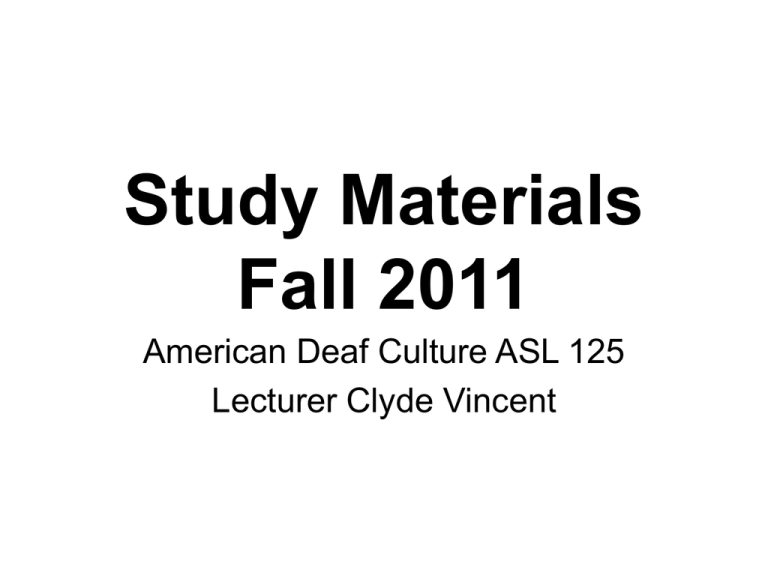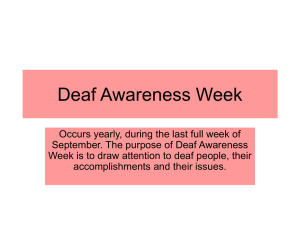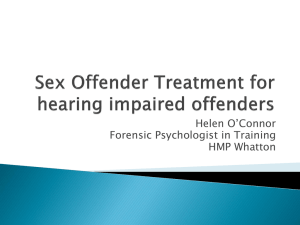CULTURE - Seattle Central Community College
advertisement

Study Materials Fall 2011 American Deaf Culture ASL 125 Lecturer Clyde Vincent •What is culture? •Define the meaning of culture. What is “Culture” • values, beliefs, perceptions, and behaviors • shared by members of a society • learned primarily through language • Success in crossing cultures • This demands that one learn as much as possible beforehand; • Cultivates cultural “informants” in order to receive mentoring as the new culture is negotiated Culture: Macro v. Micro USA Macroculture Cherished values and characteristics such as: fair play, ambition, competitiveness, independence, equality, and individualism USA Microcultures Sub cultures sharing attributes of the macroculture while maintaining distinct values, norms, and behaviors. One person may be part of several microcultures There is no standard definition of culture. • Culture: The system of shared beliefs, values, customs, behaviors, and artifacts that the members of society use to cope with their world and with one another, and that are transmitted from generation to generation through learning. •Clarify what it means to study a culture and the problem of interpretation of a culture The term “culture” • derived from two Latin words CULTURE • “Cultura” which means tending • “Colera” which means cherish • Our culture is comprised of: those things which we tend to cherish those things which are important to us. CULTURE • “Cultura” which means tending • “Colera” which means cherish • Our culture is comprised of: those things which we tend to cherish those things which are important to us. Over a hundred definitions of culture have been offered. Anthropological Theories Top – B. Malinowski, L.H. Morgan, E.B. Tylor, L. White, C. Geertz Bottom – F. Boas, A.R. Radcliffe-Brown, J. Steward, M. Harris • A diverse field of study encompassing many different approaches, methods, and academic perspectives • Have an understanding of the general approach to the study of culture including why, how and what to study. • Have the working definition of culture and the theoretical framework used in the course for analysis of the data to be presented. CULTURAL DIMENSIONS OF GREATEST CONCERN 1. Surface Structure – visual aspects such as language, videotapes, films, clothing, arts, etc. (Surface Structure usually increases the receptivity, comprehension, or acceptance of messages.) 2. Deep Structure – values, beliefs, philosophical assumptions, etc. (Deep Structure conveys salience and determines program or message impact.) • What are the key elements of culture? Subcultures • The cultures of groups whose values and norms of behavior differ from the dominant culture. • Members of subcultures interact frequently and share a common world view. • Subcultures share some elements of the dominant culture and coexist within it. Elements of Culture Element Examples Language English; Spanish; hieroglyphics Norms Manners Folkways Cultural forms of dress; food habits Elements of Culture Element Examples Mores Religious doctrines; formal law Values Liberty, freedom Beliefs Belief in a higher being What are beliefs? Beliefs are generalizations that you form to make sense of the world and of your experiences. They determine how events are given meaning and are at the core of your motivation to act. Beliefs usually operate at an unconscious and unquestioned level and also become self-fulfilling prophecies. Sathe’s Levels of Culture Manifest culture Manifest culture Expressed values Expressed values Water line Basic assumptions Basic assumptions Iceberg Onion A culture is a set of learned behaviors of a group of people • • • • born into a culture. brought up to the values of the culture. shaped by cultural values. enculturated into a culture. The Values in Deaf Culture Values are long range commitments to ends that Deaf people share culturally. Residential Schools young Deaf children – ASL – heritage – traditions – role models – Language ASL – heritage – traditions – communication – socialization – Clubs socialization – language (ASL) – heritage – traditions – beliefs – values – rules for behaviors – Body eyes – hands – ASL – communication – independent – performance – socialization – Young Deaf Children / Adults future politics / leadership – traditions – heritage – socialization – ties – keeping Clubs – sports – language (ASL) – Timeline of Discovery Parents School setting Deaf community As infants we begin to acquire our culture from those around us • our parents • siblings • relatives • friends • teachers • The wisdom of the group is passed down from generation to generation. Not only is culture learned, but it is shared with a very large group. Discovery of Deafness Deaf Parents Subject #1 Subject #2 Subject #3 Subject #4 Subject #5 Subject #6 Deaf adults Peer Groups Interpreters Movies Timeline What is the “formula”? Disagreements with terms Pre1960’s Manualism Deaf World Post1960’s 1960’s Discovery of true ASL language Dr. William Stokoe Late 1970’s After 1980’s New phenomenal thoughts about language and culture Dr. Vernon McCay Psychological Revolution with Tests Change consciousness DPN - ASL What is Deaf Culture? Carl Croneberg, 1965 • First to describe Deaf people as a group sharing similar attributes • Linguistic minority group • Similar issues and everyday problems as the hearing majority • Used the term “group,” not “culture” Deaf Culture: Deaf vs. deaf • Distinction first made by Woodward (1972) – deaf refers primarily to hearing loss – Deaf refers to social collectivities • What’s the “formula” for an individual to be considered Deaf? What is Deaf Culture? • Disagreements among researchers • Contradictory data from Deaf Community Kay Meadow, 1972 • Sub-culture created by the language used • Member of the culture if: –1. deaf –2. learned how to sign (at any age) Carol Padden, 1980 • Not recognized by only their hearing loss and signing skills • Other critical factors, such as when one learned the language • Dissociation from speech was introduced as an important attribute of culture Barbara Kannapell, 1989 “the bond of communication and strong relationships, and shared cultural beliefs and values make a person a member of the Deaf Culture” Culture a.) generalization b.) breakdown –1. Cultural relativism –2. Ethnocentrism –3. Enculturation The Deaf Community A Model of avenues into Deaf community membership and culture A community is a group of people • • • • Share common goals Support the goals of the community Cooperate in achieving these goals Determines the ways in which the community functions • To organize the social life and responsibilities of its members A Map of Culture Dimensions of Difference: ASL and English Based Cultures • To record the main outlines of any culture • To identify “primary message systems • To examine each system in relation to each other • To obtain the result






